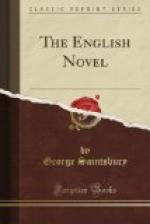Here also it has seemed fit to dwell on a single writer, not perhaps generally held to be of the absolutely first class, because these “eccentrics” are of very great importance in the history of the English novel. The danger of the kind—even more than of other literary kinds—lies in the direction of mould and mechanism—of the production, by the thousand, of things of no individual quality and character. This danger has been and is being amply exemplified. But the Peacocks (would the plural were more justified!) save us from it by their own unconquerable individuality in the first place and, in the second, by the fact that even the best in this kind is “caviare to the general,” while anything that is not the best has no attraction either for the general or the elect. They are, as it were, the salt of the novel-feast, in more senses than one: and it is cause for thankfulness that, in this respect as in the physical, England has been well off for salt-pits.
Besides these individual names—which in most literatures would be great, and even in English literature are not small—the second quarter of the century added to the history of the novel an infinity of others who can hardly appear here even on the representative or selective system. All the suns of the novel hitherto mentioned had moons and stars around them; all the cadres of the various kinds were filled with privates and non-commissioned officers to follow the leaders. Gait and Moir carried out the “Scotch novel” with something of Scott, but more of Smollett (Gait at least certainly, in part of his work, preceded Scott). Lady Morgan, who has been mentioned already, Banim, Crofton Croker, and others played a similar part to Miss Edgeworth. Glascock, Chamier, and Howard were, as it were, lieutenants (the last directly so) to Marryat. The didactic side of Miss Edgeworth was taken up by Harriet Martineau. Mrs. Shelley’s Frankenstein (1818) is among the latest good examples of the “Terror” class, to which her husband had contributed two of its worst, and two of the feeblest books ever written by a man of the greatest genius, in Zastrozzi and St. Irvyne, some seven years earlier. Many women, not unnaturally, encouraged by the great examples of Miss Burney, Miss Edgeworth, Miss Austen, and Miss Ferrier, attempted novels of the most various kinds, sometimes almost achieving the purely domestic variety, sometimes branching to other sorts. The novels of Mrs. Gore, chiefly in the “fashionable” kind, are said to have attained the three-score and ten in number; Mrs. Crowe dealt with the supernatural outside of her novels if not also in them; the luckless poetess “L.E.L.” was a novelist in Ethel Churchill (1837) and other books; Mrs. Trollope, prolific mother of a more prolific son, showed not a little power, if not quite so much taste, in The Vicar of Wrexhill (1837) and The Widow Barnaby. Single books, like Morier’s Hajji Baba




